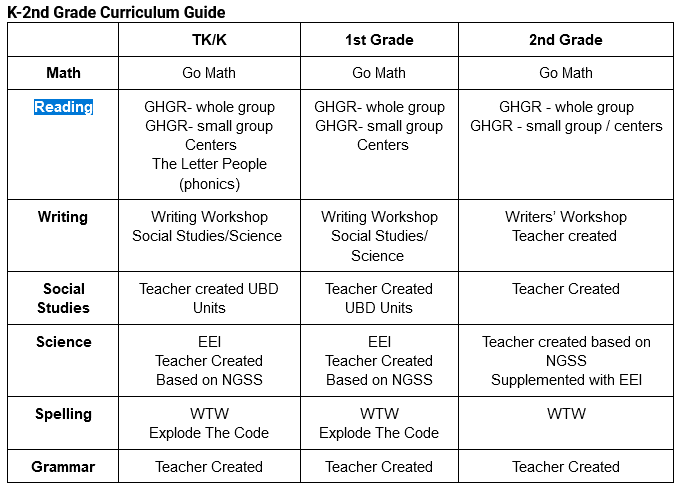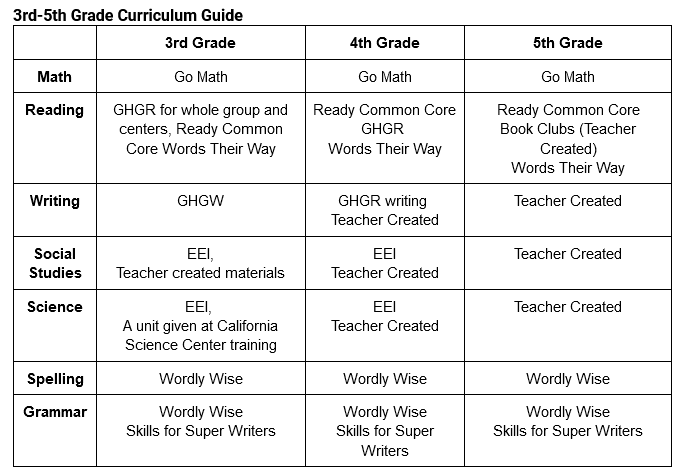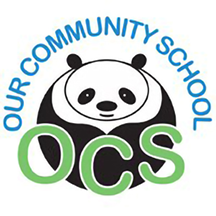Elementary


Language Arts Program (K-5th): At OCS, we strongly believe that a Common Core standard-based, balanced literacy approach best serves the needs of the emerging reader and writer and that is why our teachers selected to implement Pearson’s Good Habits, Great Readers (GHGR) language arts curriculum. Teachers use Writer’s Workshop model to instruct in writing, as well as Words Their Way for vocabulary and spelling development and Zaner Bloser Handwriting.
The GHGR program is a comprehensive reading and writing curriculum for Kindergarten through 5th grades. The program supports a proven approach to literacy learning through small group and whole group instruction. Shared reading lessons provide an opportunity for teachers to introduce key reading strategies and skills and build a common way of talking about books. During guided reading teachers provide follow-up instruction targeted to specific developmental levels. The GHGR program is premised on the seven research-based habits and strategies of great readers. It is rooted in the theory that good readers utilize specific actions (good habits) while they read, and that teachers can help students learn these habits. The program’s goal is to develop both Great Readers and Great Teachers. This program draws on the body of reading comprehension research that views reading as an active process of making sense of the text. The seven habits are as follows:
- Great Readers See themselves as Readers
- Great readers Makes Sense of Text
- Great Readers Use What They Know
- Great Readers Understand How Stories Work
- Great Readers Read to Learn
- Great Readers Monitor and Organize Ideas and Information
- Great Readers Think Critically About Books
Ready Reading is a rigorous standards-based program that builds strong, independent readers through instruction and practice with high-interest, complex informational, and literary texts. The instruction is organized around confidence-building, gradual release of responsibility model. Close reading habits are taught through authentic, complex texts that reach across the content areas. Ready Common Core is taught using whole-class instruction and small-group differentiation.
Students practice and develop skills of good reading including summarizing, predicting, visualizing, reading with expression, using text features, asking questions, making inferences, and using prior knowledge through the utilization of Book Clubs. Students work within differentiated small book clubs reading a variety of novels. Student choice is used to engage students in selecting developmentally appropriate and high-interest novels. During book club reading, students take on different jobs such as predictor: making predictions about events or characters in the book, connector: connecting events in the book to personal experiences or texts, and discussion director: leading discussions with high-order thinking questions that relate to the themes of their book.
The Letter People curriculum is used in Kindergarten and works on Phonemic Awareness, Phonics, Vocabulary, Fluency, Comprehension through the use of thematic lettered puppets. The program engages students at all levels through the use of songs and stories that help students with phonics and pre-reading skills.
For writing, teachers plan mini-lessons and create writing projects that align with grade level standards and are also a central part of many interdisciplinary studies. OCS writing instruction adheres to the following guiding principles:
- Provides California Common Core Standards-Based Instruction in writing strategies, writing applications, and written and oral language conventions: Teachers use the standards to plan writing projects and lessons to teach explicit skills in writing conventions and strategies. The students will demonstrate their learning in ongoing formative assessments of their daily writing and in benchmark writing assessments that are tied to the interdisciplinary study.
- Provides multiple times each week for children to work on their writing.
- During each day’s writing workshop, children rehearse, plan, draft, revise, and edit writing on topics that are usually chosen by the child. During the year in a writing workshop, the children work on a variety of writing, including personal narratives, essays or feature articles, short fiction, poems, procedural (or how-to) writing, and other nonfiction of various sorts. At the end of a unit of study, children’s writing is “published.” Publishing can be as simple as having a class of older children meets with younger children to read aloud their finished work. However, it does incorporate taking a draft through the phases of the writing process until it is in keeping with standardized English grammar and spelling as appropriate for the grade level.
- Explicitly teach children habits and strategies of writing, and then coach them so they can apply those strategies during independent writing. Explicit instruction is usually provided through the ten-minute-long mini-lesson, which will occur at the start of writing workshops. Teachers are encouraged to design mini-lessons in which they demonstrate a strategy and provide children with assisted practice using that strategy.
- Assess and coach writers through individual and, sometimes, small group conferences. These conferences generally begin with research and assessment. Teachers move among children during the writing workshops, holding three- to five-minute-long conferences or longer small group meetings as students write and reflect on their writing.
The core of writing instruction is built upon the steps of the writing process, i.e. brainstorming, drafting, revising, editing, & publishing. Beginning in TK/kindergarten, teachers in every grade guide students through this process so that students become independent writers who can write on demand for a variety of audiences and purposes. The writing process approach includes the use of mini-lessons. Teachers present “mini-lessons” which follow a set format: introduction of the concept and connection to the writing students are doing; modeling of the writing concept; shared application of the concept; students try it on their own; students apply the concept to their own writing. As students grow older they learn how to write in more genres and at increasingly deeper levels of depth and complexity.
Words Their Way is a vocabulary program based on years of research. the classroom-proven framework of this successful series is keyed to the five stages of spelling and orthographic development. This program offers a no nonsense method for studying words. It offers detailed directions for teachers working with students in each stage of spelling development, from emergent through derivational relations.
Additionally, we are aware that rarely can one canned program can meet the needs of all students. Because of this, we encourage our teachers to supplement the prescribed curriculum with additional tools and resources that might better fit specific needs or activities.
Our 3rd-5th grade classes also use Daily 5 as a way to allow students academic choice while working in the area of Language Arts. Daily 5 is a literacy framework that instills behaviors of independence, creates a classroom of highly engaged readers, writers, and learners, and provides teachers with the time and structure to meet diverse student needs. During Daily 5, students are able to determine which activities to work on, while understanding that all assigned tasks will need to be completed by the end of the week. Teachers also use this time to work with small groups on specific ELA skills, offering additional to support to those in need, and additional extensions where appropriate.
Math Program (Grades K-5th): Go Math is used for students in K-5th grades. This math program is organized into units of study based on groups of related skills and standards, with inquiry based lessons that build on critical thinking, analysis, and stamina. Lessons focused on depth of content knowledge, math talk questions, prompting students to use varied strategies and to explain their reasoning. Teachers encourage the use of manipulatives and drawings with the goal of transitioning from concrete pictorial understanding to a more abstract mathematical reasoning.
Mathematical Tools as Learning Supports (Manipulatives and Pictorials):
- Each user must construct his/her own meaning about mathematical tools
- Tools are used with purpose to solve problems and not as props
- Tools are used to help students record, communicate and think about mathematical problems
Equity and Accessibility
- Tasks are made accessible to all learners
- Every student has a voice in class discussions
Every student contributes.
Social Studies (Grades K-5th): Social Studies is an important part of the curriculum at Our Community School. To understand how human beings function within groups and with one another to govern their world and to create cultures that sustain us is fundamental learning for all people. All of the academic skill people learn in reading, writing and problem solving must be applied to real human problems in the world around us or there is no purpose in developing the skill. At OCS our social studies curriculum is integrated with other content areas as much as possible to give meaningful context for the study. In order to make our social studies curriculum relevant and important in our students’ lives, we also incorporate the five following elements: field trips, geography, civics, social justice and service learning.
Science (Grades K-5th): Science—and therefore science education—is central to the lives of all Americans. A high-quality science education means that students will develop an in-depth understanding of content and develop key skills—communication, collaboration, inquiry, problem solving, and flexibility—that will serve them throughout their educational and professional lives.
Consistent with the OCS school-wide philosophy of experiential, child-centered learning, OCS’s science program focuses on students using the scientific process to engage in solving real life scientific problems.
Teachers create units of study based on the Next Generation Science Standards (NGSS), which are in the process of being reviewed and adopted by California this year.
The CA NGSS are organized by these categories: Life Sciences, Earth and Space Sciences, Physical Sciences, and Engineering Design.
Structure and Arrangement of the CA NGSS
- The CA NGSS are standards, not curriculum. As of October 2018, California has not adopted any specific curriculum. Standards are goals that reflect what a student should know and be able to do. The CA NGSS does not dictate the manner or methods by which the standards are taught. The standards contain Performance Expectations (PEs) written in a way that express the concepts and skills to be performed but still leave curricular and instructional decisions to local educational agencies, districts, schools and teachers.
- Every CA NGSS standard has three dimensions: Disciplinary Core Ideas (DCI) scientific and engineering practices (SEP), and cross-cutting concepts (CCC). SEPs and CCCs are designed to be taught in context, integrated with multiple core concepts throughout each year. Engineering is integrated with the science standards through the Engineering Technology Standards (ETS), also called the Engineering Design Standards. These standards are arranged in grade bands: kindergarten through second, three through five, six through eight, and nine through twelve. The ETS standards emphasize core ideas of engineering design and technology applications.
- The Topic arrangement of the standards organizes the standards by “big ideas”. Topic examples include, but are not limited to: Chemical Reactions, Structure and Function, or Space Systems. Both arrangements support connections across the grade and between grade levels, and contain California Common Core State Standards (CA CCSS) connections: English Language Arts Standards (ELA) and Mathematics Standards.

